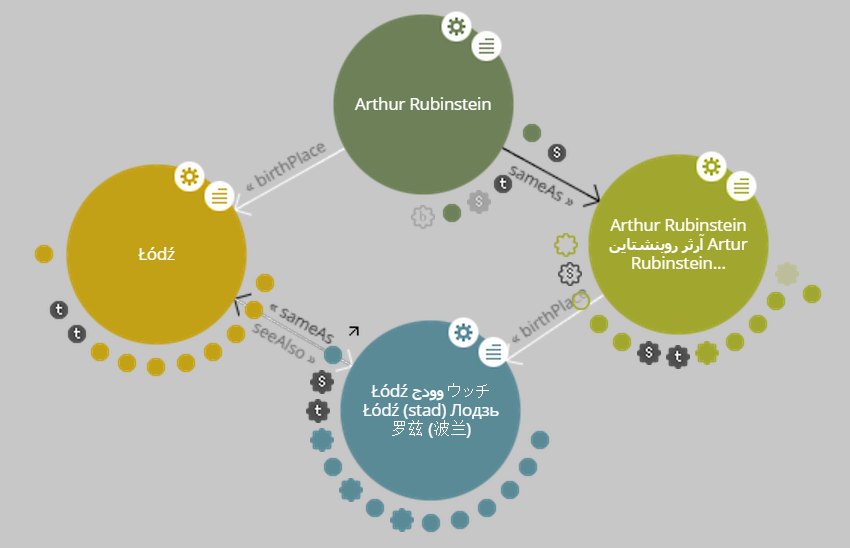Wizualizacja spuścizny kulturowej: otwarte Linked Data w Carnegie Hall cz. 2
Przedstawiamy drugą część gościnnego blogu Roberta Hudsona, archiwisty z Carnegie Hall w Nowym Jorku. W drugim odcinku Rob opowiada o wynikach swojej pracy nad przekształceniem bazy danych Carnegie Hall w postac otwartego Linked Data. Po dokonaniu konwersji i uzyskaniu ok miliona „trójek” RDF, pora na dotarcie do narzędzi pozwalających na wizualizację i przeglądanie danych. Blog jest ilustorowany nagraniami pokazującymi na żywo eksploracje danych, z komentarzem autora.
Part II: Product
 In Part I of this blog, I began telling you about my experience transforming Carnegie Hall’s historical performance history data into Linked Open Data, and in addition to giving some background on my project and the data I’m working with, I talked about process: modeling the data; how I went about choosing (and ultimately deciding to mint my own) URIs; finding vocabularies, or predicates, to describe the relationships in the data; and I gave some examples of the links I created to external datasets.
In Part I of this blog, I began telling you about my experience transforming Carnegie Hall’s historical performance history data into Linked Open Data, and in addition to giving some background on my project and the data I’m working with, I talked about process: modeling the data; how I went about choosing (and ultimately deciding to mint my own) URIs; finding vocabularies, or predicates, to describe the relationships in the data; and I gave some examples of the links I created to external datasets.
In this installment, I’d like to talk about product: the solutions I examined for serving up my newly-created RDF data, and some useful new tools that help bring the exploration of the web of linked data down out of the realm of developers and into the hands of ordinary users. I think it’s noteworthy that none of the tools I’m going to tell you about existed when I embarked upon my project a little more than two years ago!
As I’ve mentioned, my project is still a prototype, intended to be a proof-of-concept that I could use to convince Carnegie Hall that it would be worth the time to develop and publish its performance history data as Linked Open Data (LOD) — at this point, it exists only on my laptop. I needed to find some way to manage and serve up my RDF files, enough to provide some demonstrations of the possibilities that having our data expressed this way could afford the institution. I began to realize that without access to my own server this would be difficult. Luckily for me, 2014 saw the first full release of a linked data platform called Apache Marmotta by the Apache Software Foundation. Marmotta is a fully-functioning read-write linked data server, which would allow me to import all of my RDF triples, with a SPARQL module for querying the data. Best of all, for me, was the fact that Marmotta could function as a local, stand-alone installation on my laptop — no web server needed; I could act as my own, non-public web server. Marmotta is out-of-the-box, ready-to-go, and easy to install — I had it up and running in a few hours.
In addition to giving me the capability to serve up, query, and edit my RDF data, Marmotta has some great built-in visualization features. The screencast below demonstrates one of the map functions, with which I can make use of the GeoNames URIs I’ve used in my dataset to identify the birthplaces of composers and performers.
I’d like to point out two other great tools — both of which are new within about the last year — that help make the process of exploring and visualizing LOD much easier. The first of these, RelFinder, allows you to easily explore and visualize relationships within an RDF dataset. RelFinder, like Marmotta, is also very easy to download and install — basically just a Flash file and an .xml configuration file. In this screencast, you can see how I use RelFinder to examine relationships between two composers within Carnegie Hall’s data.
Another wonderful new tool called LodLive makes it possible for you to actually browse the web of linked data — simply choose a starting point, and follow your nose. LodLive consists mostly of a few jQuery plug-ins, a configuration file, and an HTML page, and is nearly as simple to set up as RelFinder. This last screencast demonstrates how I can start with a Carnegie Hall URI and then pull in and explore various connected resources.
Moving forward, I’d like to see the LOD community continue to develop more tools like RelFinder and LodLive — anything that facilitates a more seamless integration with the greater World Wide Web and helps to help unlock the capabilities of linked data for the ordinary user. At Carnegie Hall, I’d like to continue to work towards publication of our linked data, and to explore how we can utilize it. We’re in the midst of a major grant-funded digitization project — can we use LOD to increase discoverability of assets? Can we better leverage some of our existing tools, like our Performance History Search? The possibilities are exciting.
Rob Hudson
Artykuł ukazał się 19 marca 2015 w Blogu archiwistów i bibliotekarzy Instytutu Piłsudskiego
Może Cie tez zainteresować:

